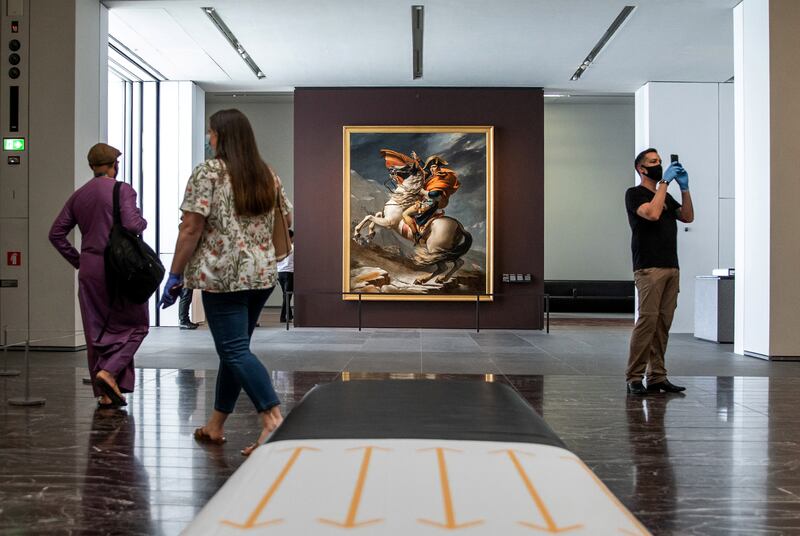Louvre Abu Dhabi is celebrating its fourth anniversary and it has changed and evolved exponentially since its first display. The museum rotates its collection every October, and has been acquiring pieces since its 2017 opening, with 56 new acquisitions currently on display.
Moreover, its loans displayed as part of the exhibitions it has hosted, thanks to the partnership between Agence France-Museums and the Department of Culture and Tourism – Abu Dhabi also means that Louvre Abu Dhabi has been host to a number of high-profile works: heavy hitters such as Rodin's The Thinker or Vincent Van Gogh's Self-Portrait.
If you missed them, here are some of the highlights from the past four years:
The world's oldest pearl
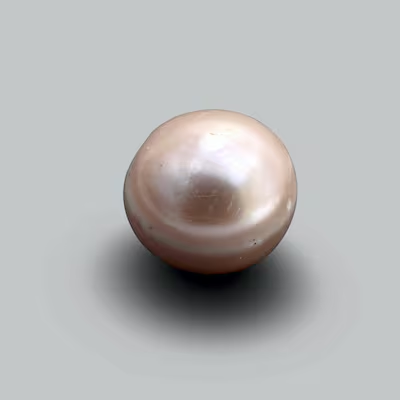
In a nod to the UAE’s pearl-diving history, in 2019 Louvre Abu Dhabi displayed what is believed to be the world’s oldest pearl. It dates back to between 5,800 BC and 5,600 BC, and was found in an archaeological dig on Marawah Island in the emirate of Abu Dhabi. The slightly gold-hued pearl would have been worn as jewellery or traded for goods, experts say. It will eventually be on show at the Zayed National Museum, but was exhibited as part of Louvre Abu Dhabi’s 10,000 Years of Luxury exhibition, from 2019 to 2020.
Leonardo da Vinci's 'La Belle Ferronniere'
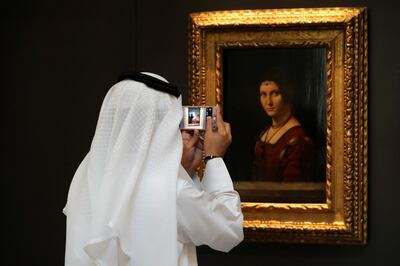
One of the indisputable stars of Renaissance portraiture, Leonardo da Vinci’s La Belle Ferronniere appeared at Louvre Abu Dhabi from its opening until September 2019, looking over her shoulder with her sceptical, serious expression. The title is thought to refer to the jewel that adorns the woman’s forehead, and was painted during what's known as Leonardo's first Milanese period, when he worked in the northern Italian city from 1482 to 1499 and produced The Last Supper, among other pieces. The work was on loan to Louvre Abu Dhabi from the Musee du Louvre in Paris.
Rodin's 'The Thinker'
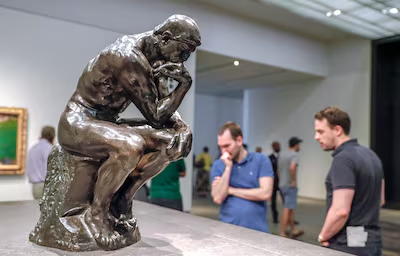
This piece, one of the world’s most famous sculptures, came to Louvre Abu Dhabi in 2019 from the Rodin Museum for the duration of the exhibition Changing Societies, Rendezvous in Paris: Picasso, Chagall, Modigliani & Co (1900-1939). The work was made between 1881 and 1882 and represents a man captured in the midst of contemplation, head on his clenched fist. It's a radical transformation from the bronze statue portraying military and political figures to an artwork that summarises an elemental human emotion. It was originally called The Poet and made for Rodin’s The Gates of Hell, a sculpture depicting a scene from Dante’s Inferno. Perched at the very top, it is believed to depict Dante himself.
Pablo Picasso's 'Young Girl with a Hoop'
The painting came to Abu Dhabi in 2019 and was also exhibited for the duration of the Changing Societies, Rendezvous in Paris: Picasso, Chagall, Modigliani & Co (1900-1939) exhibition. A masterpiece of Cubism, Young Girl with a Hoop (1919) shows a girl broken up into different geometric forms – holding a plaything of a hoop that nearly taunts the figure’s blocky fragmentation, contrasting the toy’s placid circularity with the many colours and shapes that comprise her body. The work is usually on show at the Centre Pompidou.
Vincent Van Gogh's 'Self-Portrait'
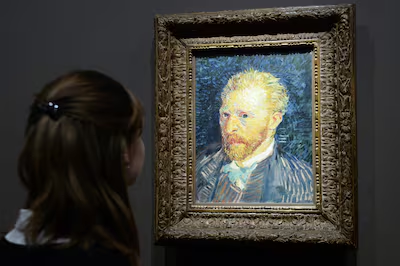
Vincent Van Gogh painted more than 35 self-portraits, most of which him with his head turned slightly to one side, eyes cooly facing the viewer. He kept the background simple, typical for paintings of the time, and the sketchy brushwork of his beard and clothing echoes the mottled, colours of heather behind him. An undated work from this famous series came to Abu Dhabi in autumn 2019, again for the Changing Societies, Rendezvous in Paris exhibition, complementing the Van Gogh work in the museum's permanent collection, the vivacious The Ballroom at Arles (1888).
Odilon Redon's decorations for the Baron and Baroness de Domecy
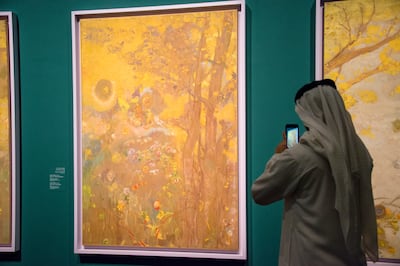
In the late 1890s, the Baron and Baroness of Domecy commissioned artist Odilon Redon to create works for their dining room that hovered between bespoke decor and artistic Modernism. Redon worked in the Chateau de Domecy-sur-le-Vault in Burgundy, France, from 1900 to 1901, eventually producing 17 panels that responded to the colours and seasons of the natural world. It was displayed at Louvre Abu Dhabi in 2018 for the duration of its Japanese Connections: Birth of Modern Decor exhibition. And as that show elaborated, it was influenced by the Japanese principles of flat perspective, centrality of nature and intense colouration.
'Portrait of a Woman' from Antinoe, Egypt
The naturalism of this portrait of a woman from Antinoe makes it the ideal example of Louvre Abu Dhabi's main principle: to highlight the universality of work across ages and civilisations. Pass by her quickly and you might think she was painted in Renaissance Italy. Her rosy cheeks, combed-back strands of hair, the shadow over her top lip – all point to the extraordinary realism associated with that period.
But she was painted between the year 100 and 120 in Upper Egypt, and according to principles more culturally Egyptian, the likeness is a funerary portrait, adorning the outside of the young woman's coffin. The work's home is now the Louvre in Paris, but she travelled back to the Middle East in 2019-2020 for the 10,000 Years of Luxury show, owing to her sumptuous gold garments and still-fashionable pearl and jewel earrings.
Letter from Mongol sultan to the king of France
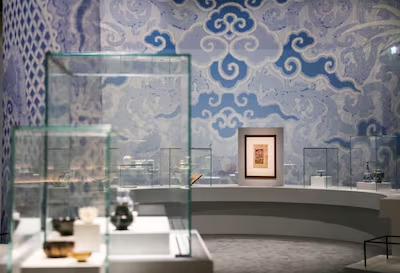
The museum's current exhibition, Dragon and Phoenix: Centuries of Exchange between Chinese and Islamic Worlds, brings a rare and stunning document from Paris's Bibliotheque Nationale to Abu Dhabi: a letter from the sultan Uljaytu of the Mongol dynasty to the king of France offering him an alliance in June 1305. Never mind that the two were not at war: it was the time of the Pax Mongolica and the Ilkhanid dynasty was used to territories grasping for treaties. The writer addressed King Philip IV the Fair, as "Sultan". He didn't reply. It is now an extraordinary example of old Mongolian script, which resembled Arabic, as well as relations between East and West at the time.
